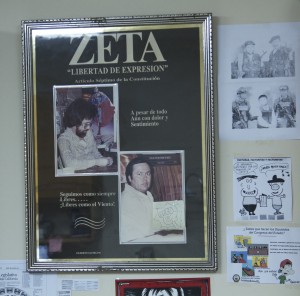As the Drug War Intensifies, Will the Free Press Be Silenced?
In 1980, Jesús Blancornelas and Héctor Félix Miranda founded the Mexican newsweekly Zeta. They intended it to stand as an independent voice, different from the rest of the nation’s largely government-controlled media. At the time, reporting the truth about the country’s leaders was unprecedented—and risky. To secure the fledgling Tijuana paper’s survival, Blancornelas and Miranda located its printing operation across the border in California. The paper’s uncompromising stand against corruption (which included poking fun at those who practiced it) would bring it 30,000 readers—and anger from the country’s leadership.
Though Blancornelas was aware that they were making enemies, Miranda’s 1988 murder shocked him and the rest of the country. And the dangers Zeta’s staff would face were only beginning. Committed to investigative journalism, the muckraking weekly began reporting on Mexico’s deadly drug cartels and the public officials secretly working for them. The Zeta staff’s brave stance—and that of like-minded journalists throughout Mexico—has since cost dozens of lives, making the neighbor to the south of the United States one of the world’s most dangerous nations for reporters. The Committee to Protect Journalists (CPJ) reports that 48 journalists were murdered or disappeared during the portion of Felipe Calderón’s tenure as president from December 2006 to the close of 2011.

Credit: Claudio Rocha/Quiet Pict
Bernardo Ruiz’s “Reportero” tells the heroic and troubling story of Zeta by following veteran reporter Sergio Haro and his colleagues. The film will premiere on PBS as a special broadcast of POV (Point of View) on Monday, Jan. 7, 2013 at 10 p.m. (Check local listings.) The film will stream on POV’s website, www.pbs.org/pov/reportero, from Jan. 8 – Feb. 7, 2013.
In 1980, the Mexican media didn’t look favorably upon reporters like Jesús Blancornelas who challenged the party line. After being fired by five newspapers, Blancornelas took matters into his own hands, founding Zeta and initially managing it from the United States. The paper, owned by journalists, attracted other talented journalists, including Sergio Haro, who first joined as a photographer in 1987.
Héctor Félix Miranda, Zeta’s co-founder, became one of its most popular columnists, writing humorously about the foibles of Mexico’s politicians and social elite, using tips from readers happy to see these once-untouchable figures brought down to earth. “My work in Zeta is proof that freedom of expression exists in Mexico,” said Miranda. “That others don’t practice it is their own fault.” It was assumed there would be some pushback, but what happened was horrific and unexpected: On April 20, 1988, Miranda was shot dead by thugs who worked for Jorge Hank, son of one of Mexico’s most powerful families. Hank was never investigated and would later be elected mayor of Tijuana.
Gradually, the government’s hold over the media loosened. But Zeta was developing a far more deadly enemy. By the early 1990s, drug trafficking was becoming a major industry along Mexico’s border with the United States. Cartels generated huge sums of money and used it to fund lavish lifestyles, recruit a revolving network of dealers and pay off police and government officials. The drug gangs’ violent rule enveloped the entire border region. “As journalists, we couldn’t ignore this real problem,” says Zeta co-director Adela Navarro, “so Zeta began to investigate narco-trafficking.”
Taking a stand against the traffickers had its price. In 1997, Blancornelas was ambushed by 10 gunmen working for a cartel that had moved from Sinaloa to Tijuana to traffic shipments of cocaine into the United States. Blancornelas survived only because, in a moment of poetic justice, shrapnel from one of the gunmen’s bullets ricocheted and struck the gang’s lead assassin in the eye, killing him.
In 1997, Haro left Zeta to found another independent newspaper, Siete Días, with Benjamín Flores. Flores was an ambitious reporter, and the paper took an aggressive stance against local drug lords. “Benjamín was very young, but grounded,” says Haro. “Daring and audacious. But given the kind of reporting he was doing, I thought Benjamín didn’t understand what he was getting into.” Flores was murdered just days after his 29th birthday; his killer was apprehended but set free by Mexico’s judiciary.
Haro retaliated through the press…
Finish reading Targeted by Mexico’s Deadly Drug Cartels, Journalists at a Tijuana Newsweekly Risk Their Lives to Report the Truth






Comment(1)
“Reportero” « cervantes empresario inovador
[…] Targeted by Mexico’s Deadly Drug Cartels, Journalists at a Tijuana Newsweekly Risk Their Lives… (latinalista.com) […]